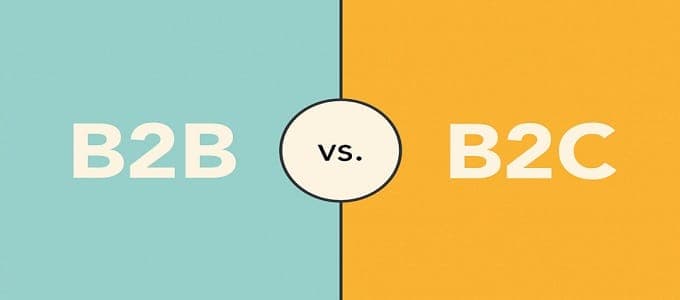
The Difference Between B2C and B2B Market Research. What Every Marketer Should Know.
B2C and B2B Market Research
Because of the dramatic differences between B2C and B2B markets, research in these environments must recognize and accommodate them to be successful.
Sample Determination
To allow analysis by various segments, including cross-tabbed groupings, it is not unusual to have sample sizes of several thousand in B2C studies. For many B2B studies, there may be only a handful of people capable of answering the key questions. Common sample sizes for B2B studies would be between 10 and 150.
A second key consideration is that while B2C decision makers outnumber B2B decision makers by about 28 to 1, all B2B customers are not equal. As George Orwell eloquently wrote in his novel, 1984, some are more equal than others. The Pareto Principal suggests that in the average business 80% of revenue comes from only 20% of customers, and in most markets that level of purchasing concentration is true or even exceeded.
Consequently, B2B research should include a disproportionally large percentage of larger customers to accurately reflect the revenue mix of the customer base. The larger sample at larger customers is comprised of different buying influences within that company. So, contacts from several different functional areas would be included and their responses considered separately in the final analysis.
Data Collection Methodologies
Because the target respondents for B2B research are usually middle managers and above, it is more practical and cost-effective to gather information using telephone, web and email surveys. Face-to-face interviews are rarely conducted partially due to the cost and also due to the difficulty of scheduling an interview. Focus groups are also very difficult to pull off in B2B markets and rarely utilized. It is challenging to get professionals together in the same time and space, plus participants would often be competitors and simply unwilling to participate in a conversation including potentially sensitive subjects.
Almost all B2C market research studies involve mixed methodologies. However, in B2B research it is much more common to utilize only one data collection methodology. This is the case because B2B markets are relatively complex, statistical confidence is difficult to assess and frequently is not even considered, however, there is a need to capture enough data to make results meaningful – if not statistically significant. As a result, the in-depth interview (commonly referred to as IDI) is quite common in qualitative B2B studies.
In studies involving voice of the customer, the sponsoring company will usually provide the contact list. It is standard operating procedure to identify the project sponsor in survey communications with the customer. This legitimizes the survey effort but does not have a negative effect on the quality of response as customers recognize the filtering capability of a third party. However, the interviewer should be expert at handling potentially difficult and sensitive information. The interviewer also has the ability to retain anonymity as deemed necessary.
Whatever data collection approach is used, B2B questionnaires must incorporate the complexity of underlying value propositions. Attributes are detailed and carefully worded to capture product performance, associated service (customer service, technical support, sales), corporate values (trust, integrity, fair price) and overall indicators of performance (satisfaction, loyalty, perceived value).
Questionnaire Design
B2B buyers tend to be more logical, often using detailed decision criteria. To the B2B buyer, corporate brands that convey integrity, trust, and quality (product and service) are more important than product brands. And B2B marketing messages are communicated more in person since the small number of buyers makes that contact cost-justified.
As described in more detail in the FAQ on the differences between B2B and B2C markets, the volume of B2B products purchased, and their complexity result in buyers who have substantial technical and operational expertise. So B2B buyers seek more detailed information, develop scenarios of potential problems, research alternative products, and take other steps to minimize risk. Consequently, buying decisions are often a group or team effort.
Effective research must include the various decision influencers and gather insight into their respective roles. It is not uncommon to gather input from 5, 10 or more individuals per company to fully understand a relationship. Because of the small size of the universe, ensuring statistical significance is normally not relevant or necessary.
B2B analysis reflects the Pareto Principle (commonly referred to as the 80/20 rule) by over-weighting some respondent types. This is normally done by generating more respondents in selected segments or customer classes than in others.
Incentives
In the B2C world, incentives are commonly used and, in fact, many or most consumers would probably not participate in a survey without some kind of incentive, be it cash, gift card, or other. That is not true in the B2B environment. In many cases – even at senior levels, when dealing with technical subjects, when the subject matter is potentially sensitive or skirting on what may be perceived as proprietary, incentives are not necessary.
We have found that a well-constructed survey, with interesting subject matter that is pertinent to the respondent, and questions that are carefully worded to reflect a knowledge of the underlying subject matter, do not require an incentive. We also have found that a simple introduction drawing a linkage between participation in the survey and a benefit to the respondent is well received and circumvents the need for an (additional) incentive. For example, the survey may deal with the desired features of a new product or service, and by participating, the respondent will have a voice in what that product or service looks like. In fact, the use of an incentive may send a subtle message that the content of the survey is not interesting enough to hold the respondent’s attention – that an incentive is necessary for them to have interest in participating.

